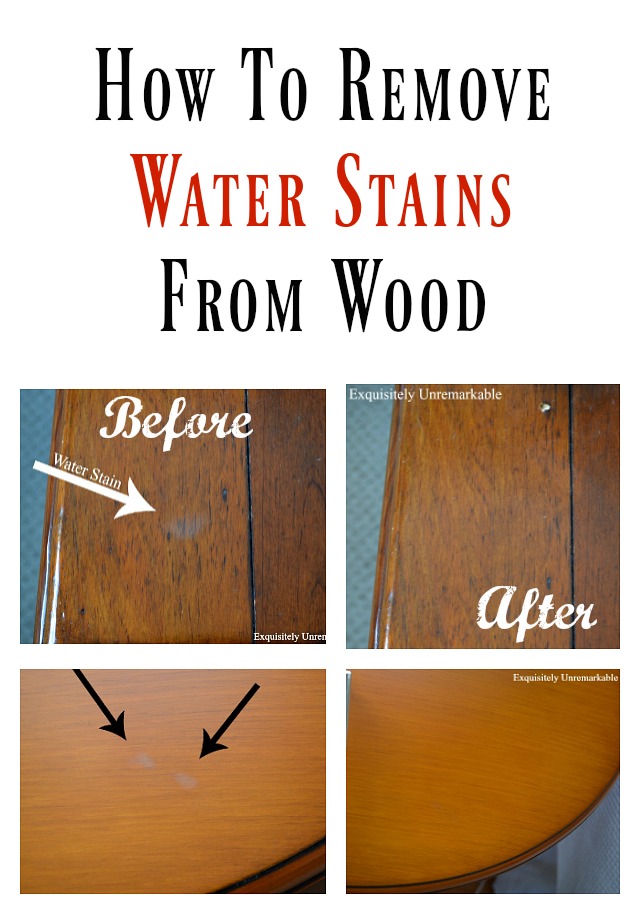Banishing Water Rings: The Subtle Art of Ironing Wood
The faint, ghostly rings left by errant water glasses on polished wood: a common domestic woe, a subtle reminder of life's little spills. But what if these spectral circles weren't indelible marks of carelessness, but rather temporary blemishes easily erased? Enter the humble iron, a household appliance typically associated with crisp linens and pressed collars, yet possessing a surprising secondary power: the ability to lift water stains from wood, restoring surfaces to their former glory.
This seemingly magical act of restoration lies in the science of heat and moisture. Water rings, often white or cloudy, are caused by trapped moisture beneath the wood's finish. Applying a controlled amount of heat through a cloth barrier allows this trapped moisture to evaporate, effectively lifting the stain. This technique, passed down through generations, speaks to a human desire not only for order but for the preservation of the beauty found in natural materials.
The precise origins of this method are shrouded in the mists of time, likely emerging alongside the widespread adoption of household irons. Before the advent of modern finishes, wood furniture was often treated with oils and waxes, making it particularly susceptible to water damage. The discovery that gentle heat could reverse this damage was undoubtedly a significant development in the care and preservation of cherished wooden pieces.
While remarkably effective, ironing wood to remove water marks carries potential risks if not executed properly. Excessive heat can scorch the wood or damage the finish, leading to more permanent blemishes. Understanding the nuances of this technique—the delicate balance of heat, moisture, and pressure—is crucial for successful restoration.
This delicate dance between preservation and potential damage highlights the importance of precision. Much like a surgeon wielding a scalpel, the person using an iron to remove water rings must exercise restraint and control. Too much heat, and the wood can scorch; too much pressure, and the finish can be marred. The goal is a gentle coaxing, a subtle encouragement of the trapped moisture to escape, leaving the wood's surface unblemished.
The benefits of using an iron to remove water stains are threefold: cost-effectiveness, accessibility, and immediate results. This method avoids the need for expensive refinishing or professional services. The tools required—an iron and a clean cloth—are readily available in most homes. And the results, when executed correctly, are often instantaneous, providing immediate gratification and restoring the wood's natural beauty.
Implementing this technique requires careful preparation and execution. Begin by ensuring the wood surface is clean and free of dust. Place a thin, clean cotton cloth over the water mark. Set the iron to its lowest heat setting, avoiding steam. Gently move the iron in small, circular motions over the cloth for a few seconds at a time. Lift the cloth periodically to check the progress. Repeat the process until the water mark disappears.
Advantages and Disadvantages of Using an Iron to Remove Water Marks from Wood
| Advantages | Disadvantages |
|---|---|
| Cost-effective | Risk of scorching or damaging the finish |
| Easy to implement | Not effective on all types of water marks |
| Uses readily available materials | Requires careful control of heat and pressure |
Best practices for this method include testing the iron on an inconspicuous area first, using a low heat setting, keeping the iron moving, and using a thin, natural fiber cloth. Avoid pressing too hard or using steam, as this can further damage the wood.
Frequently Asked Questions:
1. Can I use a steam iron? No, avoid using steam.
2. What type of cloth should I use? A thin, clean cotton cloth is ideal.
3. What if the water mark doesn't disappear? Try repeating the process with slightly more heat, but be very cautious.
4. Can I use this method on all types of wood? It's best to test on an inconspicuous area first.
5. What if I scorch the wood? Minor scorching can sometimes be buffed out with a very fine abrasive, but severe scorching may require professional repair.
6. Can I use this method on painted wood? Exercise extreme caution, as paint is more susceptible to heat damage.
7. How often can I use this method? Repeat only as needed.
8. What other methods can I try? Mayonnaise or toothpaste are sometimes suggested, but test these in an inconspicuous area first.
Tips and tricks include using a thicker cloth for deeper stains, using the tip of the iron for smaller marks, and letting the wood cool completely between attempts.
In conclusion, the technique of using an iron to remove water marks from wood stands as a testament to human ingenuity and the enduring desire to preserve the beauty of natural materials. While seemingly simple, the process requires a nuanced understanding of heat, moisture, and the delicate balance required to lift these ghostly rings without causing further damage. From its historical roots in preserving oiled and waxed furniture to its modern application on finished surfaces, this method offers a cost-effective and accessible solution to a common household problem. By following the best practices, exercising caution, and understanding the potential challenges, you can effectively banish water rings and restore your wood furniture to its former glory. Don't let the fear of potential damage deter you from exploring this simple yet effective technique. With a little practice and patience, you can master the art of ironing wood, becoming a guardian of your furniture’s enduring beauty.
Crafting meaningful quinceanera speeches a guide
Remembering john mccarthy the father of ai
Unlock your dream bathroom inspiring shower ideas from houzz














